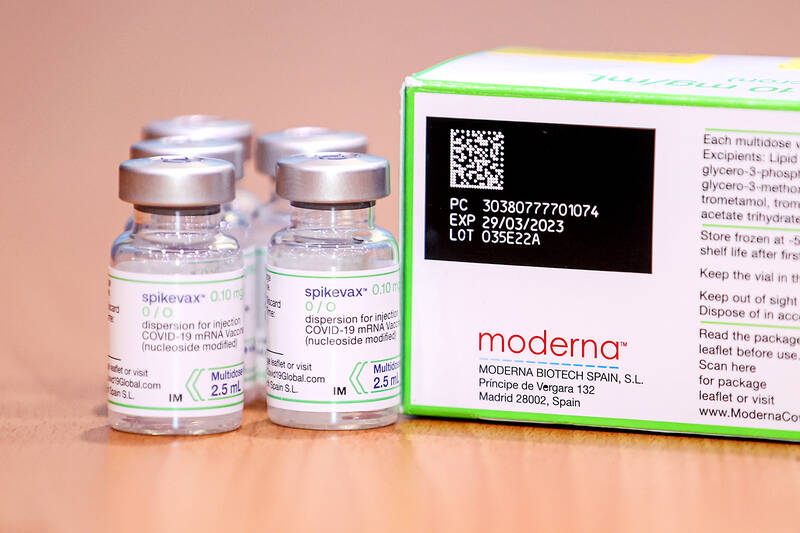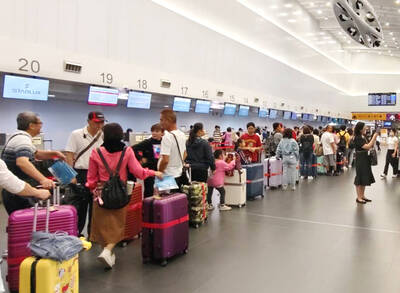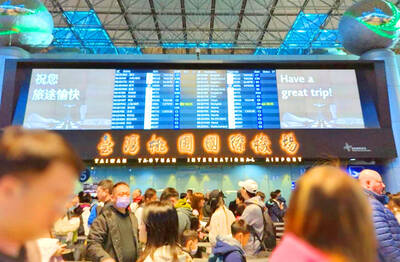Adolescents aged 12 to 17 can start receiving the Novavax COVID-19 vaccine from tomorrow, the Central Epidemic Command Center (CECC) said yesterday, adding that the second phase of inoculations using Moderna’s bivalent vaccine would begin next week.
The Ministry of Health and Welfare’s Advisory Committee on Immunization Practices has recommended that the Novavax vaccine can be administered to adolescents aged 12 to 17 as their primary series of vaccines or as a booster shot. It also allowed a mix-and-match approach.
The Novavax vaccine is a good choice for eligible recipients who are worried about possible adverse reactions from other COVID-19 vaccines, said Deputy Minister of Health and Welfare Victor Wang (王必勝), who heads the CECC.

Photo: CNA
People aged 12 or older who want to receive the Novavax vaccine as their primary series are advised to receive the same brand of vaccine for both of their doses, and receive them at least four weeks apart, advisory committee convenor and National Taiwan University Hospital pediatrician Lee Ping-ing (李秉穎) said.
People who have received other vaccine brands as their primary series can receive the Novavax vaccine as their booster dose, on condition that they receive it at least 12 weeks after the last dose of the primary series, he said.
Very common adverse reactions of the Novavax vaccine include headache, nausea or vomiting, muscle pain, joint pain, pain at the injection site, fatigue and weakness, which could occur in at least 10 percent of the recipients, Lee said.
Common adverse reactions include redness or swelling at the injection site, fever, chills and body aches, which could occur in less than 10 percent of recipients, he said.
Rare adverse reactions, such as a rash, swollen lymph nodes and hypertension, might not have been caused by the vaccine, but they were still reported, he added.
“Generally speaking, the risk of experiencing post-vaccination adverse reactions [from the Novavax vaccine] is low compared with other COVID-19 vaccines, and most are mild reactions, which do not require hospitalization,” Lee said.
Clinical trials of the vaccine have found that the most common adverse reactions are headache, fatigue and muscle pain, and that only about 6 percent developed a fever after getting the vaccine, which is less than the ratio for mRNA-based or recombinant COVID-19 vaccines, he said.
Wang said the second phase of inoculations using Moderna’s bivalent COVID-19 vaccine, which has been adapted to fight the Omicron variant of SARS-CoV-2, would begin on Monday next week.
Eligible recipients include healthcare workers; airport, harbor and quarantine workers; airline crew members and sailors; care facility and social welfare facility workers; people aged 50 to 64; and people aged 18 or older who are traveling abroad for diplomatic, public affairs or business purposes, he said.
The bivalent vaccine would be offered as a booster shot, he said.
It should be received at least 12 weeks (84 days) later than the previous shot — including the last dose of the primary series or the previous booster shot, he added.
People who want to receive the bivalent vaccine for overseas travel should bring either an invitation from abroad, an approval document from the competent government agency, or an approval document from their employer, along with their National Health Insurance card, COVID-19 vaccination certificate, also known as the “Yellow Card,” and plane tickets when getting vaccinated, the CECC said.

Three Taiwanese airlines have prohibited passengers from packing Bluetooth earbuds and their charger cases in checked luggage. EVA Air and Uni Air said that Bluetooth earbuds and charger cases are categorized as portable electronic devices, which should be switched off if they are placed in checked luggage based on international aviation safety regulations. They must not be in standby or sleep mode. However, as charging would continue when earbuds are placed in the charger cases, which would contravene international aviation regulations, their cases must be carried as hand luggage, they said. Tigerair Taiwan said that earbud charger cases are equipped

Foreign travelers entering Taiwan on a short layover via Taiwan Taoyuan International Airport are receiving NT$600 gift vouchers from yesterday, the Tourism Administration said, adding that it hopes the incentive would boost tourism consumption at the airport. The program, which allows travelers holding non-Taiwan passports who enter the country during a layover of up to 24 hours to claim a voucher, aims to promote attractions at the airport, the agency said in a statement on Friday. To participate, travelers must sign up on the campaign Web site, the agency said. They can then present their passport and boarding pass for their connecting international

Temperatures in northern Taiwan are forecast to reach as high as 30°C today, as an ongoing northeasterly seasonal wind system weakens, the Central Weather Administration (CWA) said. CWA forecaster Tseng Chao-cheng (曾昭誠) said yesterday that with the seasonal wind system weakening, warmer easterly winds would boost the temperature today. Daytime temperatures in northern Taiwan and Yilan County are expected to range from 28°C to 30°C today, up about 3°C from yesterday, Tseng said. According to the CWA, temperature highs in central and southern Taiwan could stay stable. However, the weather is expected to turn cooler starting tonight as the northeasterly wind system strengthens again

Taiwan sweltered through its hottest October on record, the Central Weather Administration (CWA) said yesterday, the latest in a string of global temperature records. The main island endured its highest average temperature since 1950, CWA forecaster Liu Pei-teng said. Temperatures the world over have soared in recent years as human-induced climate change contributes to ever more erratic weather patterns. Taiwan’s average temperature was 27.381°C as of Thursday, Liu said. Liu said the average could slip 0.1°C by the end of yesterday, but it would still be higher than the previous record of 27.009°C in 2016. "The temperature only started lowering around Oct. 18 or 19